Tools Required
J 8001 Dial Indicator Set

The best way to check lateral runout is with the wheels still installed on the vehicle. This gives a much more accurate reading of the Total Indicated Runout (TIR) under real braking conditions. If equipment is not available to perform the check with the wheels installed, the next best reading can be made with the wheels removed but with the brake caliper still installed.
In some cases, excessive lateral runout can be improved by indexing the brake rotor on the hub that is one or two bolt positions from the original position. If the lateral runout cannot be corrected by indexing the brake rotor, check the hub and bearing assembly for excessive lateral runout or looseness. If the hub and bearing assembly lateral runout exceeds 0.040 mm (0.0016 in), replace the hub and/or bearing assembly if necessary. If the lateral runout is not within specifications, refinish or replace the brake rotor as necessary.
- Set the parking brake.
- Block the vehicle wheels.
- Raise the vehicle. Refer to Lifting and Jacking the Vehicle in General Information.
- Support the vehicle with safety stands.
- Remove the tires and wheels. Refer to Tire and Wheel Removal and Installation in Tires and Wheels.
- Clean the brake rotor surface.
- Tighten the wheel bearings to zero end play.
- Fasten a dial indicator to the steering knuckle so that the indicator button contacts the brake rotor surface about 25.4 mm (1 in) from the outer edge.
- Set the dial indicator to zero.
- Turn the wheel one complete revolution.
- Observe the runout indicated on the dial.
- The (TIR) must not exceed 0.13 mm (0.005 in).
- Adjust the wheel bearings. Refer to Wheel Bearing Adjustment .
